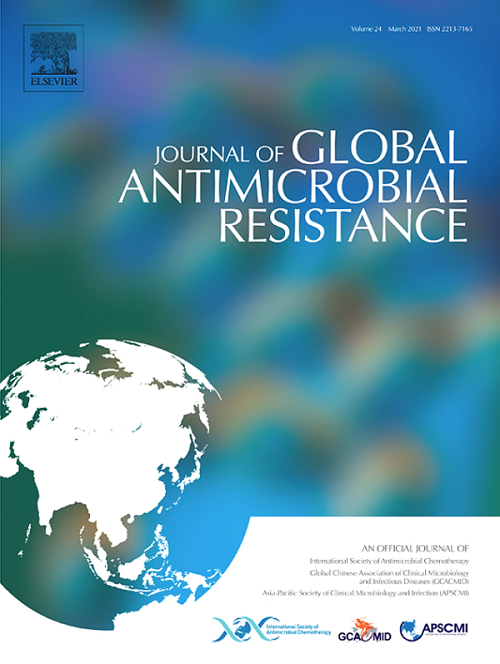blaNDM-5-encoding ST171 Enterobacter hormaechei: A global genomic and epidemiological perspective
IF 3.2
3区 医学
Q2 INFECTIOUS DISEASES
引用次数: 0
Abstract
Objective
Six blaNDM-5-positive carbapenem-resistant Enterobacter hormaechei isolates were collected from the emergency intensive care unit of a tertiary hospital in China. This study aimed to conduct a comprehensive genomic and epidemiological analysis of ST171 E. hormaechei harbouring blaNDM-5 on a global scale.
Methods
Whole-genome sequencing was performed using the Illumina platform, and the genomic characteristics of the isolates were analysed using multiple bioinformatics tools. E. hormaechei strains carrying blaNDM-5 were retrieved from the National Center for Biotechnology Information database. A single nucleotide polymorphism-based phylogenetic tree for ST171 E. hormaechei strains was constructed using Snippy v4.6.0.
Results
Six ST171 E. hormaechei strains carrying blaNDM-5 were isolated from different patients in the EICU over a 9-month period. These strains exhibited resistance to all tested antimicrobial agents except for sulfamethoxazole/trimethoprim and colistin. A total of 12 antimicrobial resistance genes, including blaNDM-5, were identified in these strains. Phylogenetic analysis revealed that all six strains belonged to the same clonal lineage, indicating nosocomial transmission. A comprehensive search of the National Center for Biotechnology Information database identified 75 ST171 E. hormaechei strains carrying blaNDM-5, predominantly of clinical origin, with the highest prevalence in China and the United States. Clonal dissemination was observed both within hospitals and between healthcare facilities in these two countries.
Conclusions
blaNDM-5-positive ST171 E. hormaechei strains have emerged globally, with significant prevalence in China and the United States. Our study underscores the clonal spread of these strains within hospitals and across healthcare facilities. Continuous surveillance of these strains is crucial for the effective prevention and control of antimicrobial resistance.
编码ST171霍马氏肠杆菌的blandm -5:全球基因组学和流行病学视角
目的:从中国某三级医院急诊重症监护病房收集6株blandm -5阳性耐碳青霉烯类肠杆菌。本研究旨在对全球范围内携带blaNDM-5的ST171荷氏大肠杆菌进行基因组学和流行病学分析。方法:采用Illumina平台进行全基因组测序,并利用多种生物信息学工具分析分离株的基因组特征。从NCBI数据库中检索携带blaNDM-5的荷氏大肠杆菌菌株。利用Snippy v4.6.0构建了基于单核苷酸多态性(SNP)的ST171荷氏大肠杆菌系统发育树。结果:在9个月的时间里,从EICU的不同患者中分离出6株携带blaNDM-5的ST171荷氏大肠杆菌。这些菌株对除磺胺甲恶唑/甲氧苄啶和粘菌素外的所有抗微生物药物均表现出耐药性。在这些菌株中共鉴定出包括blaNDM-5在内的12个耐药基因。系统发育分析显示,所有6株均属于同一克隆谱系,表明存在医院传播。通过对NCBI数据库的全面检索,确定了75株携带blaNDM-5的ST171荷氏e型菌株,主要来自临床,在中国和美国的患病率最高。在这两个国家的医院内和医疗机构之间均观察到克隆传播。结论:blandm -5阳性ST171荷氏大肠杆菌已在全球范围内出现,在中国和美国有显著流行。我们的研究强调了这些菌株在医院内和医疗机构之间的克隆传播。对这些菌株的持续监测对于有效预防和控制抗微生物药物耐药性至关重要。
本文章由计算机程序翻译,如有差异,请以英文原文为准。
求助全文
约1分钟内获得全文
求助全文
来源期刊

Journal of global antimicrobial resistance
INFECTIOUS DISEASES-PHARMACOLOGY & PHARMACY
CiteScore
8.70
自引率
2.20%
发文量
285
审稿时长
34 weeks
期刊介绍:
The Journal of Global Antimicrobial Resistance (JGAR) is a quarterly online journal run by an international Editorial Board that focuses on the global spread of antibiotic-resistant microbes.
JGAR is a dedicated journal for all professionals working in research, health care, the environment and animal infection control, aiming to track the resistance threat worldwide and provides a single voice devoted to antimicrobial resistance (AMR).
Featuring peer-reviewed and up to date research articles, reviews, short notes and hot topics JGAR covers the key topics related to antibacterial, antiviral, antifungal and antiparasitic resistance.
 求助内容:
求助内容: 应助结果提醒方式:
应助结果提醒方式:


